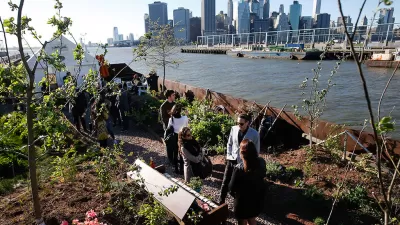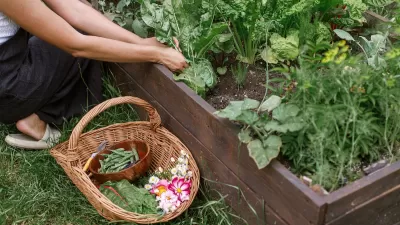Be a better person; be a better planner. Musings from a planner who wants to improve our profession for 2011. Here’s how:
Be a better person; be a better planner. Musings from a planner who wants to improve our profession for 2011. Here's how:
1. Live up to the intrigue of the profession. Yes,when I tell people I'm a City Planner I can see a hint of envy in their expression. City planner has an immediate coolness factor. It oozes power and mystery. And I have to imagine that most planners felt this way about the profession when they first started their careers. How extraordinary to shape cities and make them better places to live. To improve people's lives with small changes and big ones too. Like the hand of God playing with tiny model buildings, moving mountains, streams, and trees. If we're lucky we'll all have a chance to work on one phenomenal project- a Millenium Park, a Portland Streetcar, a Manhattan High Line Park, a South Beach renaissance. But in the meantime, why not ramp up our planning work, revive that cool persona and be a better planner?
2. Eat less. Exercise more. No you're not fat, but our cities are. Let's do a better job planning for parks, jogging paths, walking paths, and walkable blocks. Mandate streets which are interesting to walk down. Plant more trees, require storefronts which are scaled to people and connect places with more attractive routes to make longer distances seem shorter. Give people a reason to walk. Work with all the departments in your city to do this. Planners are interdisciplinary by education. Use this skill to design our cities for recreation and activity.
3. Promote urban farming. Do you know where the lettuce from salad was grown or where that chicken you're about to eat was raised? Why should you care? Massive commercialization of farms and meats has created an extremely convenient and reliable food supply which is efficiently distributed to the nation and the world, but the model is inherently fragile and raises questions about long term sustainability and self sufficiency. Food sources are not clearly labeled and it is difficult to measure the social and environmental impact of transporting that unripe avocado from a nameless California City to my local grocery store in Miami not to mention the low-income neighborhoods which don't even have a decent place to buy avocados. Locally grown and raised food circumvents this system and offers high quality alternatives for a community. As planners we can make it easier for small local and urban farmers to plant, grow, and sell produce within the community by developing policies and regulations which not only permit these uses, but encourage them with incentives.
4. Stop letting large-scale developers design our cities. I'm so tired of reading about the next big mixed-use development and communities hedging their bets on a single project. Great cities aren't made by lifestyle retail centers or glorified shopping malls, they are made with incremental investments from many different people. People who are risk takers with a vision. Cultivate these small investors in your community. Make it easier to develop on small lots and remove the financial barriers which discourage the individual entrepreneur from taking that risk toward making their neighborhoods better places to live. Provide good information on the permitting process and develop ways to expedite approvals for small projects. Create redevelopment districts which attract small investors and discourage large scale homogeneous development.
5. Don't underestimate the importance of aesthetics, sense of community, and social offerings for making cities where people want to live long term. In their Soul of the Community study, the James L. Knight Center and Gallup polled 26 cities three times in three years and found that in all 26 cities a place's beauty, it's tolerance for different people and families, and its cultural and recreational amenities connect people most to their cities and keep them there. More important than economics, politics, and education, people want to live in cities that offer a better quality of life. Consider this information when budgeting for the next fiscal year and setting goals for planning in your community. Set higher standards for arts and culture and invest in your parks, museums, and waterfronts. It's what people want and its what they need. www.soulofthecommunity.org/
So at the start of this new year consider how to be a bolder professional, make great cities, and be better planner!

Alabama: Trump Terminates Settlements for Black Communities Harmed By Raw Sewage
Trump deemed the landmark civil rights agreement “illegal DEI and environmental justice policy.”

Study: Maui’s Plan to Convert Vacation Rentals to Long-Term Housing Could Cause Nearly $1 Billion Economic Loss
The plan would reduce visitor accommodation by 25% resulting in 1,900 jobs lost.

Planetizen Federal Action Tracker
A weekly monitor of how Trump’s orders and actions are impacting planners and planning in America.

Wind Energy on the Rise Despite Federal Policy Reversal
The Trump administration is revoking federal support for renewable energy, but demand for new projects continues unabated.

Passengers Flock to Caltrain After Electrification
The new electric trains are running faster and more reliably, leading to strong ridership growth on the Bay Area rail system.

Texas Churches Rally Behind ‘Yes in God’s Back Yard’ Legislation
Religious leaders want the state to reduce zoning regulations to streamline leasing church-owned land to housing developers.
Urban Design for Planners 1: Software Tools
This six-course series explores essential urban design concepts using open source software and equips planners with the tools they need to participate fully in the urban design process.
Planning for Universal Design
Learn the tools for implementing Universal Design in planning regulations.
Caltrans
Smith Gee Studio
Institute for Housing and Urban Development Studies (IHS)
City of Grandview
Harvard GSD Executive Education
Toledo-Lucas County Plan Commissions
Salt Lake City
NYU Wagner Graduate School of Public Service






























